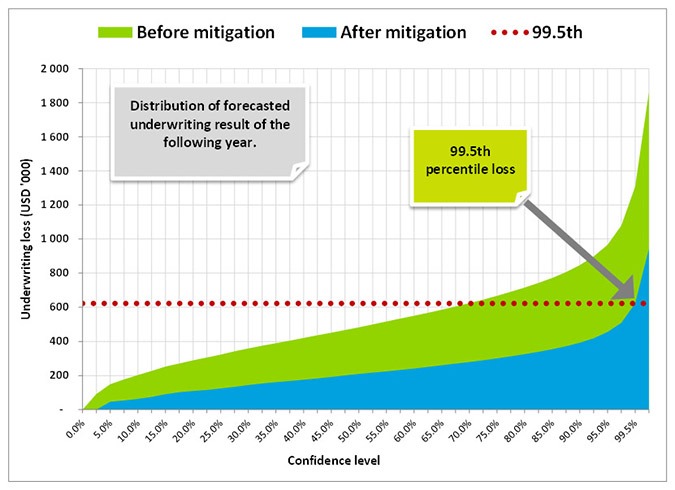
Global consultancy Deloitte uses @RISK to help insurers determine the risks that they may be exposed to when considering cell captive insurance policies.
The insurance business is inherently risky—so much so, that many companies in that sector are finding ways to side-step some of its trickiest aspects. This adds a layer of complexity that requires careful risk assessment and decision making for those who are ultimately liable when the claims do come in. Global consultancy Deloitte uses @RISK to help clients with some of these delicate choices.
Cell Captive Insurance and Risk
Cell captive insurance is a niche insurance industry that is growing in acceptance and use. A cell captive insurer allows other companies (i.e. the “cell owners”) to ‘piggyback’ onto the host insurer’s license, so that each of the cell businesses doesn’t have to deal with the prohibitive costs and regulations that come with buying their own licenses. The cell owners then perform certain functions on behalf of the cell captive insurer (“the insurer”) in respect to certain insurance products underwritten by the insurer. Cell captive insurers take on significant risk when entering into these types of arrangements. Not only is the insurer exposed to a range of operational risks, the insurer will also always remain liable for any valid claims related to policies written on its license, even if the insurer did not write the policies themselves.
In most cases it is a requirement that the cell owners capitalize the cell at the outset. This capital acts as a buffer which the insurer can use, under certain conditions, to honor its obligations. This is usually achieved through a purchase of insurer shares by the cell owner which effectively gives the cell owner the right to do business on the insurer’s license.
There are many factors that the insurer will consider before allowing a third party to write insurance business on its license. One very important factor to consider is the risks that the insurer will be exposed to. The value of the capital required by the insurer at outset is usually calculated using risk-based methodologies where the insurer will consider its potential risk exposures over a future period of time (e.g. one year). Experts at Deloitte risk management use @RISK to help cell captive insurance clients make informed choices around these delicate decisions.
About Deloitte
Deloitte, a leading global professional services firm, offers services in cell captive insurance risk analysis, along with a suite of other services in the areas of audit, tax, consulting and financial advising. Liran Blasbalg, an actuarial analyst at Deloitte South Africa, has used @RISK to help cell captive insurers determine which companies to partner with and the amount of capital required by the insurer to capitalize the cell should the insurer enter into such an arrangement with a cell owner. “Cell captive insurers need to understand the potential impact on the insurer’s solvency position from writing specific types of business,” says Blasbalg. “So we help them perform a realistic assessment of what the risk is of partnering with a firm.”
Hedging for Hailstorms
To advise their clients, Blasbalg conducts economic capital calculations, which require the use of Monte Carlo methods to estimate the amount of capital required to remain solvent under a stressed scenario. A stressed scenario, explains Blasbalg, is a “One-in-200-year event—like a severe hailstorm or a devastating earthquake —anything that can lead to an accumulation of claims or a very large individual claim that can threaten the insurer’s solvency,” he says. “It is important to form a view on the likely value of the losses in catastrophic scenarios.”
To analyze these high-stress scenarios, Blasbalg builds stochastic models that project both the revenue account and balance sheet over a future time period, usually one year. Each iteration of the model represents one possible outcome of, for example, the forthcoming year’s underwriting experience. The model is run 100,000 times to produce a distribution of the cell’s underwriting experience from which the 99.5th percentile loss can be read off the distribution. Insurance companies are only concerned about the costly and rare worst-case scenarios, so instead of looking at the whole distribution, Blasbalg focuses on the ‘tail’ of the distribution—the extreme version of potential outcomes. “We always take a one-in-200-year view,” says Blasbalg. The 99.5th percentile forecasted loss is then taken as the likely loss, given the underlying assumptions, in a one-in-200-year event.
ALiran Blasbalg
Actuarial Analyst, Deloitte Sout Africa
Clear Benefits with @RISK
“@RISK gives us the power to perform Monte Carlo methods in a single cell in Excel. This saves us time and simplifies the spreadsheets we work in,” says Blasbalg, explaining the integral part that @RISK plays in solving these kinds of problems. “@RISK includes a very useful feature called the Compound function that combines the twin uncertainties of likelihood of loss and severity of loss in a single calculation. Without @RISK we would essentially have to make use of tens of thousands of rows to run our model. @RISK gives us access to many distributions that can’t be found in Excel, and also allows us to fit distributions to previous loss data easily.”
“Allowing for correlations between the different classes of business, perils and types of claims is also a very important component of the models that we build,” he continues. “@RISK’s correlation functions allow us to build in correlation structures with any distribution.” These correlation structures represent relationships between variables – such as storm categories and property loss – that are critical for accurate modeling.
Although the model and analysis are complicated, the results need to be clear when presented to decision-makers. Says Blasbalg: “@RISK also provides easy-to-interpret and useful summaries which would take time to prepare if done so without @RISK.” Deloitte has found @RISK to be a powerful tool for risk analysis around cell captive insurance, enabling them to advise clients in a risky and complex field.

@RISK enables Deloitte to forecast loss risks and take appropriate mitigation actions to reduce those risks to acceptable levels.
